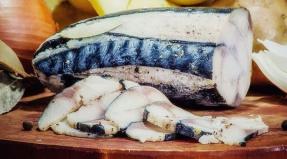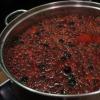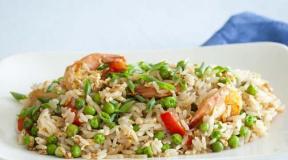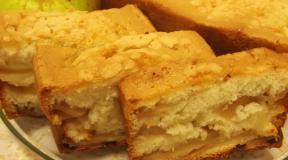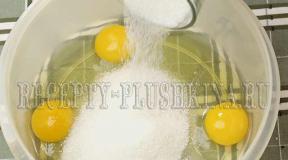Photographs of recipes for the dishes of the USSR for the holidays. Hot dishes of Soviet cuisine
Many treat the recipes of the USSR era with disdain. What could be cooked there if there was not even butter on the store shelves? But even without jamon, dor blue and marzipans, Soviet women created real masterpieces. Here are just the most popular ones.
Olivier salad
The Soviet version of the salad was very different from the pre-revolutionary one. It was so "based on" that it could well be called a parody. Neither hazel grouses, nor pressed caviar, nor crayfish ...
The Soviet version, familiar to us, was invented in the Moscow restaurant in the capital immediately after the revolution. All the tastiest things disappeared from it, and the hazel grouses were generally replaced with boiled chicken. And in times of special "revelry" of developed socialism, many housewives generally abandoned poultry, replacing it with boiled sausage. Oddly enough, it was in this form that the salad became known almost all over the world. In Europe it is now called "Russian salad", which, in general, is fair.
How to cook. Everything is very simple. To begin with, they boiled potatoes, meat, eggs, took pickled cucumbers from a barrel or jar, brought onions from the cellar and opened a jar of green peas. Now the most dreary thing remained: everyone was chopping into cubes, except for peas, of course. Mayonnaise, salt, pepper were added, and the last magic action: mixed. For a normal bowl of salad, a pound of meat is enough, the same amount of potatoes, ten eggs, five cucumbers, two onions and a jar of peas.
How to make it tastier. First, you can make mayonnaise yourself with olive oil, rather than buying it at the store. Secondly, it is not forbidden to add shrimp to all this riot. For happiness, you need three hundred grams, do not regret it.
Shuba salad
There is a very beautiful revolutionary legend. Say, during the Civil War, not indifferent Komsomol members came up with the proletarian salad Sh.U.B.A., abbreviated to Chauvinism and Decline - Boycott and Anathema. The salad included the simplest ingredients, without any bourgeois excesses.
Believe in this story or not - everyone's personal business. The "fur coat" became popular after the war, and Soviet cookery can be proud of it - this is an absolutely unique dish that immediately became popular. But, unlike "Olivier", in the world it is known exclusively as "this extravagant Russian salad with herring", or "oh my God, why do they do this."
How to cook. There are many variations of the recipe, but they all have one thing in common: you need boiled beets. In addition to her, the usual list includes boiled potatoes, carrots and also herring. Not everyone can stand the vegetarian option with seaweed. Vegetables were boiled, cooled, peeled, chopped or grated. The herring was also crushed, vegetable oil was added. The whole point of the salad is that the products were laid in layers and each of them was smeared with mayonnaise from the heart. The very first was herring, then carrots, potatoes and beets. Ideal proportions: there should be as much of each vegetable in the salad as the herring base.
How to make it tastier. Do not spare mayonnaise - the salad loves it. Nowadays, in addition to traditional ingredients, onions and eggs are often added. Neither one nor the other "fur coat" will definitely spoil. Gourmets use salted red fish instead of herring, but this, you see, is somehow not proletarian.
Passenger salad
Another invention of Soviet chefs. Unique, although not as popular. Most of the housewives got to know him thanks to the cookbooks of the seventies and were still very surprised: why is he called "Passenger"? Mayonnaise somehow does not imply long-term storage, salads are not taken on a hike, you cannot quickly cut it by the fire.
There is a version that in the sixties this dish was actively promoted in restaurant cars. In addition to the memoirs of individual railroad workers, no other evidence of this could be found.
How to cook. There are only three main products in the salad, plus the constant dressing - mayonnaise. It was made from beef liver, which was first fried in large pieces and then cut into strips. Pickles were cut in the same way. The onions, chopped into half rings, were sautéed. Then all this was mixed, salted, pepper and the magic "Provencal" was added. Half a kilo of liver took the same amount of onions and half as many cucumbers.
How to make it tastier. The combination of products is almost perfect, hardly anyone will be able to achieve the best. However, some housewives, at the request of faint-hearted husbands, reduce the amount of onions. Doubtful step.
Student soup
You cannot find this recipe in a Soviet cookbook, but any student who studied then remembers it perfectly. And even in several versions - depending on the available products and financial capabilities.
For some reason, modern Russian websites and communities devoted to cooking are strongly demanding the use of broth in the recipe. Of course, "Studencheskiy" is similar to French cheese soups, but there was no question of any special broth. All meat broth was provided exclusively by sausages.
How to cook. As usual, it all starts with peeling potatoes (0.5 kg). In a completely hopeless situation, it was replaced with pasta, but it was not so tasty. It also required three hundred grams of sausages, a carrot, an onion and two processed cheese. The simplest grocery set that could easily be bought without using connections. When the water boiled, finely chopped onions and carrots were thrown there. Sausages were also crushed, usually cut into circles - it's easier this way. At the very end came the turn of processed curds.
How to make it tastier. This is where the real scope for imagination is. Students, to enrich their taste and out of despair, did not add anything: from bell peppers to olives. And the taste did not lose from this.
Pea soup
The history of pea soup goes back several millennia. There are references to him in Ancient Greece, Rome, medieval treatises. In Russia, he is also known for a long time and is even mentioned in "Domostroy".
In the USSR, it was prepared from dry peas or special briquettes with semi-finished products. Due to its cheapness, it was especially loved in workers' and student canteens. At home, “musical soup” was also periodically prepared, but the dish was not festive at all.
How to cook. It is useless to consider the option with a briquette: the cooking method is painted on the wrapper. If it was made from dry peas, it was pre-soaked for 6-8 hours. Onions, carrots, any smoked meats or bacon were chopped and fried. Be sure to peel some potatoes, literally two or three things. It was boiled together with peas until half cooked, then everything was added from the pan. When the soup was ready, croutons were thrown into the plate. 250 grams of peas took 200 grams of meat, one carrot, an onion and 0.6 liters of water.
How to make it tastier. It is not at all necessary to stop at one type of smoked meats. Soup with two or even three types of meat will be much better.
Naval macaroni
Soviet interpretation of Italian pasta. The exact history of this dish is unknown. It appeared in cookbooks in the sixties, but it has been mentioned before. Most likely, this is a classic "folk art", which was also liked by the professionals of the cookery business. Naval pasta was offered in canteens of almost all institutions and especially often in sanatoriums, boarding houses and pioneer camps. Their administration simply adored this recipe: it was almost impossible to understand how much meat was actually put there. Minced meat was mixed with noodles and tomatoes were not used, as is done in modern recipes.
How to cook. Ingenious in its simplicity composition. It contains only three products: minced meat, one onion and the actual pasta. No complicated manipulations were required either. A pound of minced meat was fried in oil until cooked, the onion was added and kept on fire until it darkened. Pepper and salt. Simultaneously, the same amount of vermicelli was boiled. Then the water was drained and the minced meat was added directly from the pan. Be sure to mix thoroughly.
How to make it tastier. Adding something to this perfection means moving away from the original idea and getting closer to what is prepared in Italy. Well, okay, cheese or herbs will not be superfluous.
Potatoes with stew
It is now impossible to repeat this recipe. The problem is the stew. The one that is sold in stores is not at all suitable in quality. There is almost no meat, just some strange "jellied meat". You can stew the meat yourself, but it doesn’t quite taste the same, it’s not Soviet at all. Why this happens is a big mystery. It remains only to feel nostalgic and get by with the current stew. But you should buy only the highest quality products: the rest is too doubtful.
How to cook. Probably everyone has already guessed: the Soviet cuisine won over with its simplicity. And this time everything is also elementary. The potatoes were peeled, cut into large pieces and set to boil. Having brought to half-readiness, the stew was added. Straight through the entire contents of the jar. There is a widespread recipe on the Internet in which the "white fat" is offered to be removed and thrown away. Frankly speaking, this is blasphemy, for this it is necessary to transfer to a lifelong lean menu.
How to make it tastier. Many women have tried to improve this recipe. The easiest way is to add canned green peas. You can also chop and fry some onions and carrots. In general, there is room for delicious creativity.
Chicken Kiev
The de-volai cutlets of French origin became the prototype. The difference is only one and insignificant, to be honest. The French put a sauce inside theirs, usually creamy with mushrooms. Soviet citizens did not engage in such tenderness: a small piece of butter and green tea were enough. Initially, only foreigners in the Intourist system were pleased with the Kiev cutlet, but luxury has moved from restaurants for the elite to Soviet cuisines.
How to cook. Perhaps this is the most difficult dish in terms of preparation in our review. Don't be fooled by the simple name "cutlet" - for cooking, they used not minced meat, but a chicken fillet chop. And for the filling, the greens were finely chopped and mixed with butter, which was taken directly from the freezer. The resulting mixture was laid out on a cue ball and wrapped so that a neat oval cutlet was obtained. Then it was rolled in egg and bread crumbs and placed in a preheated frying pan. Fried on both sides until a crust appeared. The final stage is ten minutes in the oven.
How to make it tastier. No way. Attempts to add mushrooms or cheese inevitably turn it into a "de-will" cutlet.
Semolina
The invention is not Soviet, but it was in the USSR that it got into every home. In Russia, they began to prepare it back in the 19th century, but exclusively in noble families. For common people, semolina was too expensive. But the Soviet authorities, rebuilding the food industry from scratch, launched its mass production, and flour mills literally filled up shops with semolina. And it would be fine only shops - in schools and pioneer camps she was suppressed almost every morning. And no one stirred the lumps, of course ... Yes, this porridge turned into a nightmare for Soviet children.
How to cook. It's a shame to call this process “cooking”. Milk was poured into a saucepan, waited until it boils, and then little by little they poured semolina. For half a liter of milk, there are only 3 tablespoons of cereal. Stirring slowly, sugar and a pinch of salt were added. This step took 5-10 minutes. At the end, a piece of butter was thrown in and thoroughly mixed again.
How to make it tastier. It is better to take semolina porridge as the "base" of a sweet dish. You can add fresh and canned fruits, candied fruits, nuts, chocolate and just jam there.
Napoleon cake"
The most popular cake of those times. At the same time, it was not sold in stores or served in restaurants, it was exclusively “home production”. Each housewife had her own recipe and her own secret, although they were all, in fact, very similar.
This cake came to Russia from Europe and, despite the name, most likely from the Italian city of Naples. In the USSR, they began to cook it especially often in the eighties, when the deficit became simply depressing - the so-called "Napoleons for Poverty", where the cream was made from melted ice cream.
How to cook. Pre-prepared cakes from puff pastry. It was believed that the thinner they turned out and the more they were used, the cooler, but the main secret of taste is still the cream. Custard was used in the USSR. For him, they put one and a half liters of milk on a slow fire, at the same time grinded yolks (8 pcs.), Sugar (400 g) and a bag of vanilla sugar, then added 100 grams of flour. All this must be added to the milk that had boiled by that time. Bring to a boil again and stir until the cream thickens. They were carefully coated with cakes and put in the refrigerator. For the dough itself, three hundred grams of butter, 600 grams of flour, half a tablespoon of vinegar, a little salt, an incomplete glass of water and two eggs were required.
How to make it tastier. Spoiling a classic cake is easier than improving it, but there are some tips for Napoleon too. For example, you can add three tablespoons of brandy to the dough, and butter to the cream.
People whose childhood fell on the period of the USSR and Perestroika have something to remember about those distant times. Some say that life was bad during the era of the Soviet Union, while others, on the contrary, consider these times the best in their lives. Nevertheless, both had their favorite dishes and products that left pleasant memories in the soul of everyone who was born and raised in Soviet times. The set of the food basket of the Soviet person was not distinguished by a variegated variety, so people invented and invented new dishes from the same products. Let's take a nostalgic look and remember what was on the table of every Soviet person.
Bread crust
Running to the store for bread was one of the first tasks given to a Soviet child. And so, headlong, you run to the nearest store. Squeezing a penny in a small palm, stand in line and wait for the aunt in a high cap to turn to you. But you can go home slowly. Still would! There is a fragrant crust that cannot be resisted. Well, who among us has not brought home a slightly bitten bread?
Caramel cockerels

Cockerels, bunnies, chanterelles - sweets took on all sorts of shapes. But they were all made from sugar and melted butter. You could buy both in the store and in the market from enterprising grandmothers. Where is the chupa-chupsu to take.
Gum

When in the early 90s we watched cassettes with foreign films to the core, we always tried to resemble beautiful heroes in some way. The chewing gum, which they always had with them, was a luxury for many children. But that didn't stop them. Admit it, you chewed on the resin of fruit trees too!
Bagel bunch

Competing with a variety of biscuits and tender biscuits, bagels have lost their popularity. And about 30 years ago they were bought in bundles. And while mother or grandmother was busy with business in the kitchen, each girl considered it necessary to try on a bunch. Awesome decoration!
Bread with sugar

Now we buy or prepare a variety of desserts, and at that time the most favorite delicacy was a piece of white bread with butter, abundantly sprinkled with sugar. When there was no butter, the bread was simply moistened with water and then sprinkled with sweet sugar.
Cookie sandwich

Remember cookies with baked milk? It was so tasty and aromatic that it was hard to wait for the kettle to boil. And to make it even tastier, it was enough to grease one cookie with butter and cover such a filling with the second.
Condensed milk in a tin can

Today, the choice of condensed milk is so great that your eyes run wide. And before in stores, they built pyramids from one type - liquid condensed milk. To grease wafer cakes or cook toffee, condensed milk was boiled. Sometimes after that midnight they washed the walls and ceiling. But the "explosive" delicacy was never given up.
Butterscotch

Here they are, candy that could be eaten indefinitely. Well, if not indefinitely, then just to the pain in the stomach. Yes, you can find something vaguely reminiscent of the taste of those same toffee in your local store. But only those who have lost their fillings after every second candy will feel the difference.
Cheese "Druzhba"

Today you can find products under this name, but it does not repeat the same Soviet taste. Previously, cheese was added to a variety of dishes or simply ate a bite to tea.
Dessert "Nut"

Some people still have a baking dish for such nuts. After all the twists and turns with the can of condensed milk, the women kneaded a special dough and brought it to readiness in the form, and then stuffed the nuts with boiled condensed milk. Of course, half a can of condensed milk disappeared without a trace in the process.
Halva

Of those few products that have always been on store shelves and remained available, there was also halva. Today, many are surprised that such a product was sold in cans. But for children of that time, this is quite normal.
Kissel in briquettes

Why wait for mom to come home from work and cook strawberry jelly? It is enough to print the pack and gnaw on the briquette. Then, of course, the parents scolded, but the game was worth the candle. Did you do that?
Toast

Where do you put stale bread today? If you were transported 30 years ago, then this question would not torment you: cut it into pieces, dip it in a beaten egg and fry it in a hot frying pan until crisp. Generation of a toaster never dreamed of!
Kvass

As soon as the heat sets in, the store shelves are filled with a drink called "Kvass". If you grew up in the Soviet Union, you know that the modern dark drink has nothing to do with real kvass. At that time, in the kitchen of every decent housewife there was a three-liter jar with bread crumbs at the bottom. This is how delicious kvass was prepared.
Homemade kozinaki

The fragrant and delicious sweetness was prepared at home, as it was quite difficult to find it in the store. It would seem that there is nothing tricky or special: pour the peeled seeds with caramel, wait until the mass hardens, divide into briquettes. A broken tooth, and not even one, is a traditional consequence.
Baked potato

Many more years will pass until the newfangled word "barbecue" will accompany conversations about outings in nature. In the meantime, you can just light a fire and throw in a few potatoes. Break off a twig from the nearest bush and use it to turn the potato. Then you take it out, throw it from hand to hand, peel off the peel, eat while still hot ... An excellent master class for modern children.
Bread with vegetable oil

So, the instruction is for those for whom such a combination does not seem like a delicacy at all: take a piece of rye bread, grease it with vegetable oil and sprinkle with salt, as well as chopped green onions. The children were delighted!
Cookies "Potato"

The famous Soviet dessert resembles a potato only in shape. These are actually cookies, cocoa, melted butter and nuts. Mixed, sculpted balls - the dessert is ready.
Doctor's sausage

It still exists today. But not like that. Probably, at that time they used a special recipe that has been lost over the years. While someone was just making themselves sandwiches with boiled sausage for tea, others were frying it. So it became even tastier and there was nothing better.
Jam and black bread

Modern kids eat glazed curds, chocolate bars and cupcakes. And we cut off a piece of black bread and opened a jar of currant jam. No creams, jams and marmalades can compare with such a dessert.
Many treat the recipes of the USSR era with disdain. What could be cooked there if there was not even butter on the store shelves? But even without jamon, dor blue and marzipans, Soviet women created real masterpieces.
Olivier salad
The Soviet version of the salad was very different from the pre-revolutionary one. It was so "based on" that it could well be called a parody. Neither hazel grouses, nor pressed caviar, nor crayfish ...
The Soviet version, familiar to us, was invented in the Moscow restaurant in the capital immediately after the revolution. All the tastiest things disappeared from it, and the hazel grouses were generally replaced with boiled chicken. And in times of special "revelry" of developed socialism, many housewives generally abandoned poultry, replacing it with boiled sausage. Oddly enough, it was in this form that the salad became known almost all over the world. In Europe it is now called "Russian salad", which, in general, is fair.
How to cook. Everything is very simple. To begin with, they boiled potatoes, meat, eggs, took pickled cucumbers from a barrel or jar, brought onions from the cellar and opened a jar of green peas. Now the most dreary thing remained: everyone was chopping into cubes, except for peas, of course. Mayonnaise, salt, pepper were added, and the last magic action: mixed. For a normal bowl of salad, a pound of meat is enough, the same amount of potatoes, ten eggs, five cucumbers, two onions and a jar of peas.
How to make it tastier. First, you can make mayonnaise yourself with olive oil, rather than buying it at the store. Secondly, it is not forbidden to add shrimp to all this riot. For happiness, you need three hundred grams, do not regret it. 
Shuba salad
There is a very beautiful revolutionary legend. Say, during the Civil War, not indifferent Komsomol members came up with the proletarian salad Sh.U.B.A., abbreviated to Chauvinism and Decline - Boycott and Anathema. The salad included the simplest ingredients, without any bourgeois excesses.
Believe in this story or not - everyone's personal business. The "fur coat" became popular after the war, and Soviet cookery can be proud of it - this is an absolutely unique dish that immediately became popular. But, unlike "Olivier", in the world it is known exclusively as "this extravagant Russian salad with herring", or "oh my God, why do they do this."
How to cook. There are many variations of the recipe, but they all have one thing in common: you need boiled beets. In addition to her, the usual list includes boiled potatoes, carrots and also herring. Not everyone can stand the vegetarian option with seaweed. Vegetables were boiled, cooled, peeled, chopped or grated. The herring was also crushed, vegetable oil was added. The whole point of the salad is that the products were laid in layers and each of them was smeared with mayonnaise from the heart. The very first was herring, then carrots, potatoes and beets. Ideal proportions: there should be as much of each vegetable in the salad as the herring base.
How to make it tastier. Do not spare mayonnaise - the salad loves it. Nowadays, in addition to traditional ingredients, onions and eggs are often added. Neither one nor the other "fur coat" will definitely spoil. Gourmets use salted red fish instead of herring, but this, you see, is somehow not proletarian. 
Passenger salad
Another invention of Soviet chefs. Unique, although not as popular. Most of the housewives got to know him thanks to the cookbooks of the seventies and were still very surprised: why is he called "Passenger"? Mayonnaise somehow does not imply long-term storage, salads are not taken on a hike, you cannot quickly cut it by the fire.
There is a version that in the sixties this dish was actively promoted in restaurant cars. In addition to the memoirs of individual railroad workers, no other evidence of this could be found.
How to cook. There are only three main products in the salad, plus the constant dressing - mayonnaise. It was made from beef liver, which was first fried in large pieces and then cut into strips. Pickles were cut in the same way. The onions, chopped into half rings, were sautéed. Then all this was mixed, salted, pepper and the magic "Provencal" was added. Half a kilo of liver took the same amount of onions and half as many cucumbers.
How to make it tastier. The combination of products is almost perfect, hardly anyone will be able to achieve the best. However, some housewives, at the request of faint-hearted husbands, reduce the amount of onions. Doubtful step. 
Student soup
You cannot find this recipe in a Soviet cookbook, but any student who studied then remembers it perfectly. And even in several versions - depending on the available products and financial capabilities.
For some reason, modern Russian websites and communities devoted to cooking are strongly demanding the use of broth in the recipe. Of course, "Studencheskiy" is similar to French cheese soups, but there was no question of any special broth. All meat broth was provided exclusively by sausages.
How to cook. As usual, it all starts with peeling potatoes (0.5 kg). In a completely hopeless situation, it was replaced with pasta, but it was not so tasty. It also required three hundred grams of sausages, a carrot, an onion and two processed cheese. The simplest grocery set that could easily be bought without using connections. When the water boiled, finely chopped onions and carrots were thrown there. Sausages were also crushed, usually cut into circles - it's easier this way. At the very end came the turn of processed curds.
How to make it tastier. This is where the real scope for imagination is. Students, to enrich their taste and out of despair, did not add anything: from bell peppers to olives. And the taste did not lose from this. 
Pea soup
The history of pea soup goes back several millennia. There are references to him in Ancient Greece, Rome, medieval treatises. In Russia, he is also known for a long time and is even mentioned in "Domostroy".
In the USSR, it was prepared from dry peas or special briquettes with semi-finished products. Due to its cheapness, it was especially loved in workers' and student canteens. At home, “musical soup” was also periodically prepared, but the dish was not festive at all.
How to cook. It is useless to consider the option with a briquette: the cooking method is painted on the wrapper. If it was made from dry peas, it was pre-soaked for 6-8 hours. Onions, carrots, any smoked meats or bacon were chopped and fried. Be sure to peel some potatoes, literally two or three things. It was boiled together with peas until half cooked, then everything was added from the pan. When the soup was ready, croutons were thrown into the plate. 250 grams of peas took 200 grams of meat, one carrot, an onion and 0.6 liters of water.
How to make it tastier. It is not at all necessary to stop at one type of smoked meats. Soup with two or even three types of meat will be much better. 
Naval macaroni
Soviet interpretation of Italian pasta. The exact history of this dish is unknown. It appeared in cookbooks in the sixties, but it has been mentioned before. Most likely, this is a classic "folk art", which was also liked by the professionals of the cookery business. Naval pasta was offered in canteens of almost all institutions and especially often in sanatoriums, boarding houses and pioneer camps. Their administration simply adored this recipe: it was almost impossible to understand how much meat was actually put there. Minced meat was mixed with noodles and tomatoes were not used, as is done in modern recipes.
How to cook. Ingenious in its simplicity composition. It contains only three products: minced meat, one onion and the actual pasta. No complicated manipulations were required either. A pound of minced meat was fried in oil until cooked, the onion was added and kept on fire until it darkened. Pepper and salt. Simultaneously, the same amount of vermicelli was boiled. Then the water was drained and the minced meat was added directly from the pan. Be sure to mix thoroughly.
How to make it tastier. Adding something to this perfection means moving away from the original idea and getting closer to what is prepared in Italy. Well, okay, cheese or herbs will not be superfluous. 
Potatoes with stew
It is now impossible to repeat this recipe. The problem is the stew. The one that is sold in stores is not at all suitable in quality. There is almost no meat, just some strange "jellied meat". You can stew the meat yourself, but it doesn’t quite taste the same, it’s not Soviet at all. Why this happens is a big mystery. It remains only to feel nostalgic and get by with the current stew. But you should buy only the highest quality products: the rest is too doubtful.
How to cook. Probably everyone has already guessed: the Soviet cuisine won over with its simplicity. And this time everything is also elementary. The potatoes were peeled, cut into large pieces and set to boil. Having brought to half-readiness, the stew was added. Straight through the entire contents of the jar. There is a widespread recipe on the Internet in which the "white fat" is offered to be removed and thrown away. Frankly speaking, this is blasphemy, for this it is necessary to transfer to a lifelong lean menu.
How to make it tastier. Many women have tried to improve this recipe. The easiest way is to add canned green peas. You can also chop and fry some onions and carrots. In general, there is room for delicious creativity. 
Chicken Kiev
The de-volai cutlets of French origin became the prototype. The difference is only one and insignificant, to be honest. The French put a sauce inside theirs, usually creamy with mushrooms. Soviet citizens did not engage in such tenderness: a small piece of butter and green tea were enough. Initially, only foreigners in the Intourist system were pleased with the Kiev cutlet, but luxury has moved from restaurants for the elite to Soviet cuisines.
How to cook. Perhaps this is the most difficult dish in terms of preparation in our review. Don't be fooled by the simple name "cutlet" - for cooking, they used not minced meat, but a chicken fillet chop. And for the filling, the greens were finely chopped and mixed with butter, which was taken directly from the freezer. The resulting mixture was laid out on a cue ball and wrapped so that a neat oval cutlet was obtained. Then it was rolled in egg and bread crumbs and placed in a preheated frying pan. Fried on both sides until a crust appeared. The final stage is ten minutes in the oven.
How to make it tastier. No way. Attempts to add mushrooms or cheese inevitably turn it into a "de-will" cutlet. 
Semolina
The invention is not Soviet, but it was in the USSR that it got into every home. In Russia, they began to prepare it back in the 19th century, but exclusively in noble families. For common people, semolina was too expensive. But the Soviet authorities, rebuilding the food industry from scratch, launched its mass production, and flour mills literally filled up shops with semolina. And it would be fine only shops - in schools and pioneer camps she was suppressed almost every morning. And no one stirred the lumps, of course ... Yes, this porridge turned into a nightmare for Soviet children.
How to cook. It's a shame to call this process “cooking”. Milk was poured into a saucepan, waited until it boils, and then little by little they poured semolina. For half a liter of milk, there are only 3 tablespoons of cereal. Stirring slowly, sugar and a pinch of salt were added. This step took 5-10 minutes. At the end, a piece of butter was thrown in and thoroughly mixed again.
How to make it tastier. It is better to take semolina porridge as the "base" of a sweet dish. You can add fresh and canned fruits, candied fruits, nuts, chocolate and just jam there. 
Napoleon cake"
The most popular cake of those times. At the same time, it was not sold in stores or served in restaurants, it was exclusively “home production”. Each housewife had her own recipe and her own secret, although they were all, in fact, very similar.
This cake came to Russia from Europe and, despite the name, most likely from the Italian city of Naples. In the USSR, they began to cook it especially often in the eighties, when the deficit became simply depressing - the so-called "Napoleons for Poverty", where the cream was made from melted ice cream.
How to cook. Pre-prepared cakes from puff pastry. It was believed that the thinner they turned out and the more they were used, the cooler, but the main secret of taste is still the cream. Custard was used in the USSR. For him, they put one and a half liters of milk on a slow fire, at the same time grinded yolks (8 pcs.), Sugar (400 g) and a bag of vanilla sugar, then added 100 grams of flour. All this must be added to the milk that had boiled by that time. Bring to a boil again and stir until the cream thickens. They were carefully coated with cakes and put in the refrigerator. For the dough itself, three hundred grams of butter, 600 grams of flour, half a tablespoon of vinegar, a little salt, an incomplete glass of water and two eggs were required.
How to make it tastier. Spoiling a classic cake is easier than improving it, but there are some tips for Napoleon too. For example, you can add three tablespoons of brandy to the dough, and butter to the cream. 
This part of the Soviet menu has always been in the spotlight. Which, in general, is quite understandable. The not too rich table of our fellow citizens forced them to consider all other dishes only as a prelude to the main thing - hot. That is why, having become the apotheosis of the Soviet table, hot dishes have absorbed all the peculiarities of our 20th century cooking.
The turning point was the famous "The Book of Delicious and Healthy Food", which from 1939 to 1990 was regularly published in millions of copies. She significantly expanded the range of dishes recommended to the Soviet reader. Along with porridge, pancakes and compotes, there were recipes for stuffed carp in sour cream, fried veal, and all kinds of butter sauces. The recommended cooking technique also became much more complicated: it was assumed that the Soviet hostess would not only cook and fry, but also bake and stew. The list of the most common and popular Soviet hot dishes is quite predictable: meat dishes based on minced meat or small cuts, since a large piece of good meat was an infrequent guest on Soviet tables; chicken or pork as the most readily available meat products; a nourishing side dish in the form of potatoes or pasta, plus a thick gravy, as a way to increase the calorie content of a meal while maintaining its taste.
Perhaps a classic example of this trend is navy-style pasta - one of the most iconic and widespread Soviet everyday dishes. This is a kind of lifesaver for a caring housewife, and for a completely lazy inept, and for most public catering establishments. Everything is simple: boil broth and boiled meat, passing through a meat grinder, mix with pasta or noodles. You can, of course, not be too lazy and fry the onions in sunflower oil, and if in butter, it’s much tastier. 
Meatballs with pasta
Another classic Soviet hot dish is cutlets and meatballs. Probably, there are as many family recipes as there are housewives. But as for canteens, restaurants, the production of semi-finished products - everything is strict here, according to the "Collection of recipes ...", no amateur performances. Cutlets, meatballs, schnitzels, steaks, zrazy and meatballs - all these are dishes, primarily from minced meat, minced meat. Cutlets and meatballs - the mince is the same, the difference in shape is the oval cutlet, flattened, pointed at one end; the cue ball is round, flattened. The addition of white, stale bread soaked in water is strictly regulated. Fried in bread crumbs. Who remembers, the cutlet cost 11 kopecks in the dining room!  The cutlets were different - from stolovskaya for 11 kopecks to Pozharsky ones in a restaurant.
The cutlets were different - from stolovskaya for 11 kopecks to Pozharsky ones in a restaurant.
The same minced meat, oval, flattened, but slightly larger and fried without breading - beefsteak. Chopped schnitzel is prepared from beef, with the addition of pieces of bacon, fried without breading. The menu sounded like this: "natural chopped schnitzel", served with sauce, cost 23 kopecks. Zrazy - minced meat with all kinds of filling inside: eggs, buckwheat porridge, mushrooms, and just fried onions. Meatballs - balls of minced meat with the addition of bread or rice, fried and then stewed in sauce (tomato, sour cream, red). And, of course, there are lamb, pork, poultry, fish and vegetable cutlets.
In addition to cutlets, perhaps the best thing that can be prepared from meat ground in a meat grinder is stuffed cabbage rolls, our Russian cabbage rolls in cabbage leaves. Someone boils a whole head of cabbage, and someone first takes it apart into leaves. Some prefer to stew in sour cream, while others in tomato and fried onions. As they say, taste and color ... We have our own technology at home. The main thing in it is to buy the right cabbage, of the "Slava" variety or something close to it.  Cabbage rolls are good from Slava cabbage
Cabbage rolls are good from Slava cabbage
It seems that only a mysterious Russian soul could give birth to such a dish as lazy cabbage rolls. Meanwhile, despite the uninspiring name, this is a completely independent, tasty and vitamin-rich dish. Plus, you don't have to worry about cabbage leaves, and the variety of cabbage is not important.
Dumplings. Yes, here it is - a clear illustration of the evolution of Soviet cuisine. In the "Book of tasty and healthy food" in 1939, there are only two short recipes about them: broth with dumplings and dumplings in oil (placed at the very end of the "Flour dishes" section). The 1955 "Cookery" is another matter. There are already dozens of references here: Moscow, Siberian, Uzbek dumplings, in butter with cheese, in an omelette, in tomato sauce, baked, fried. And they already appear as hot snacks, as dough products, and as dishes of national cuisines.  Dumplings
Dumplings
True, sometimes all the difference in recipes comes down to a simple phrase: "Moscow dumplings are prepared in the same way as Siberian dumplings, but they only take less dough and more minced meat." But be that as it may, dumplings are an iconic dish of our cuisine, which made a brilliant "career" during the USSR. Naturally, one of the factors of popularity was ready-made frozen dumplings, the production of which was established by the food industry. What could be easier - boiled water, salted and filled up the whole pack, 5 minutes, and you're done. You need a little skill: defrost so that they do not fall into a ball, calculate the amount of water, do not digest.
By the end of the existence of the USSR, this dish of students and bachelors became truly nationwide. Disputes about what the mince was made for them made up an indispensable part of the meal, giving grounds for the most fantastic assumptions. However, home cooking did not lag behind either. We remember the stories of how the whole family in the 1960s prepared 200-250 dumplings for the reception of guests. As a grandfather, he personally checked the salinity of the minced meat and the consistency of the dough. And how then he competed with his son-in-law, who would eat more for a bet. This dish became especially popular in private kitchens when such a form for cooking them appeared in hardware stores. It really facilitated the sculpting process, allowing you to prepare a batch of 37 dumplings in 5-7 minutes. One had only to try once to, as they say, “feel the difference”.  Once - and 37 dumplings are ready!
Once - and 37 dumplings are ready!
If we are already talking about semi-finished products, then it is appropriate to recall here the main one - sausages. Their mass production, established in the early 1930s, made a real revolution in the food system, including home. Moreover, at that time, along with the weighed-out sausages familiar to us today, their canned counterparts were produced. In canteens, sausages were served both with green peas and with a "complex" side dish: stewed cabbage and mashed potatoes were placed on a plate together. On top of the mashed potatoes cooked in water, a teaspoon of melted butter was always splashed when serving. But what kind of reconstruction of this Soviet dish we got:  Sausages with stewed cabbage under Zhigulevskoe beer
Sausages with stewed cabbage under Zhigulevskoe beer
Now, perhaps, it's time to move from minced meat dishes to natural meat. Goulash, azu, meat in sweet and sour sauce, beef stroganoff, French-style meat. This list, of course, can be continued, but in general, the set of dishes is clear. Meat subjected to prolonged heat treatment (stewing). A variety of schnitzels and steaks were to be presented as an alternative. This natural meat was also present in the menus of canteens and restaurants, but it was taken with some caution. Due to the fact that the pieces were often very hard.
They were adjoined by rump steaks, splints, escalopes, which were supposed to differ from each other only by the supposed difference - from which part of the carcass the piece was cut. In fact, I think no one really followed this. It was simply not possible to guess what was breaded under a thick layer of sour crackers. There could be no question of any degree of roasting either, they did not even know such words - Medium, Medium Rare, Well Done. In the most famous Soviet restaurants, no one would ask you how to fry meat. They served equally tasteless, tough meat from a cow that had been regularly producing record milk yields for many years before slaughter.
Chops were different for the better, from which the relative edibility was knocked out with hammers. Here, by the way, chops from a piece of veal or pork, which was successfully purchased from a familiar butcher or at the market, were successfully cooked in the home kitchen. This was probably the only way to cook a natural piece of meat at home. Therefore, it is not surprising that the main dishes both at home and in public catering were medium-sized slices of meat with various sauces, in the common people called gravies.
For canteens and restaurants, it was much more convenient - finely chopped ones cook faster, chew easier and you can't see the quality of the pieces on the plate behind the sauce. The first meat dish in popularity is undoubtedly goulash. Simple, unpretentious, does not require a high-quality, expensive piece of tenderloin. Even today, there is no particular need to make any adjustments to his recipe.  Goulash
Goulash
Meat in sweet and sour sauce is not an accidental acquaintance with taste, but a favorite dish on Soviet tables. Moreover, it took root so well in almost any family that many considered it to be their “family” recipe, regardless of nationality. In reality, of course, this is a recipe from the Jewish (Ashkenazi) national cuisine. Which left a significant mark on Soviet gastronomy.  Sweet and sour meat
Sweet and sour meat
And here is another representative of the Soviet multinational cuisine. Azu in Tatar has become an indispensable part of the menu of our catering. And in home cooking - it was a frequent guest. By the way, here's an amazing fact. Despite such popularity, this dish never appeared on the pages of KVZP (even in later editions), and in “Kulinariya” it is simply referred to as “azu” without any Tatar roots.  Another famous dish is beef stroganoff. It was born, of course, not under the USSR. Its roots, obviously, go back to the end of the 18th century. But the first mentions of Stroganoff beef in Russian cookbooks date back to the 1870s. So, by Soviet times, this dish enjoyed equal success both in our country and abroad. And the post-revolutionary Russian emigration finally spread it all over the world. At the same time, this is some kind of very "Soviet" dish. It is difficult to say what the secret of his success is. First, the relative ease of preparation, a small range of products, easy technology. Secondly, the expressive taste. Thirdly, the lack of strict regulations - the tenderloin is easily replaced with rump, sour cream - for cream, tomatoes - for the Yuzhny sauce.
Another famous dish is beef stroganoff. It was born, of course, not under the USSR. Its roots, obviously, go back to the end of the 18th century. But the first mentions of Stroganoff beef in Russian cookbooks date back to the 1870s. So, by Soviet times, this dish enjoyed equal success both in our country and abroad. And the post-revolutionary Russian emigration finally spread it all over the world. At the same time, this is some kind of very "Soviet" dish. It is difficult to say what the secret of his success is. First, the relative ease of preparation, a small range of products, easy technology. Secondly, the expressive taste. Thirdly, the lack of strict regulations - the tenderloin is easily replaced with rump, sour cream - for cream, tomatoes - for the Yuzhny sauce.
But back to meat dishes. Here it is - the signature dish of Soviet feasts - French-style meat. To be honest, no Frenchman would ever get the fancy idea of cooking mayonnaise, usually prepared by every housewife as a sauce for ready meals. The traditional French method of cooking - gratin - involves the formation of a caked golden crust on the surface. There are many recipes for gratins, with different products, including slices of meat, potatoes and onions. But they are baked, of course, not with mayonnaise (these are already our Soviet fantasies), but with béchamel sauce, or just with cream.  French meat
French meat
It is impossible not to mention offal, which in Soviet times were much cheaper than meat. Lung, kidneys, liver, heart - liver. Fried or stewed, they made an excellent filling for pies. Language - and this is already a delicacy for those times! - it was not easy to buy. Jellied tongue, served with hot mashed potatoes, or just a cold slice of it on a sandwich - this still remains both a high-quality everyday meal and a good treat for a feast. But our best memories are of the liver. Today, not everyone likes this product. But slices of high-quality fresh beef liver, fried with onions in butter - what could be tastier!
Returning to the theme of the "Soviet-multinational", we cannot ignore the memories of two dishes. One of them, of course, is Uzbek pilaf. Another "spicy national" dish is chicken. You have probably already guessed what this is about. Indeed, Georgian food habits have probably won the hearts of the Soviet people forever. Chickens in the USSR were different. Domestic - more often with the head, paws and giblets (liver, heart, stomach and neck). The head and legs of a bird, casually wrapped in a square of gray paper, stuck out spectacularly from a string bag, predicting the prospect of a fragrant soup or chakhokhbili. Imported - Hungarian or French - represented a respected broiler at the time. They, too, were with all the giblets, neatly wrapped in a separate, inside a bag.
Imported birds were most often taken in reserve and waited in the freezer until the next holiday - they were destined to become a roasted delicacy in the oven. The most "advanced" way was to fry the chicken on a bottle, smearing the carcass with mayonnaise. So, of course, the famous tobacco chicken. Hit of resort cooking. One of the favorite items in the restaurant cuisine menu. Perhaps, by the way, this was due to its technological simplicity. After all, for example, according to Soviet standards, a cook of the 6th category could cook Kiev cutlets only 60 pieces per shift. And the chicken was three thousand.  At the end of socialism, for some reason it became fashionable to argue "taBaka" or "taPaka". Supporters of the latest version referred to the Georgian name for the tapa frying pan, from which the name of the dish was supposedly to have originated. While arguing, the right chicks simply disappeared from the market, replaced by full-breasted but tasteless broilers. So for a while the discussion became strictly theoretical.
At the end of socialism, for some reason it became fashionable to argue "taBaka" or "taPaka". Supporters of the latest version referred to the Georgian name for the tapa frying pan, from which the name of the dish was supposedly to have originated. While arguing, the right chicks simply disappeared from the market, replaced by full-breasted but tasteless broilers. So for a while the discussion became strictly theoretical.
Of course, this is not a complete overview of the hot dishes of Soviet cuisine. Each of the readers will certainly be able to add at least a dozen more favorite foods from childhood. But our task was not to compile an encyclopedia of Soviet food. We just wanted to awaken your memories, to recreate the unforgettable atmosphere of a bygone era.
Imagine for a moment that you were asked to live one day in the style of the USSR. What would you cook and how would you spend your time?
We asked this question to the residents of the former Soviet Union and together with them returned several decades ago - we breathed in the aroma of Soviet buns and “Tabak” chickens. We remembered the basics of making pea soup from briquettes, table cutlets and pickled sprat, enjoyed “Nuts” with boiled condensed milk, wafer rolls and semolina meatballs.
First meal
In the Soviet Union, first courses took pride of place in the diet. They cooked them for several days at once. Lunch in canteens, and at home, always consisted of at least three courses - first, second and compote.
The most delicious first course, according to the residents of the USSR, was red borscht. Only not freshly cooked, but the one that stood in the refrigerator for a day - as they said then "infused". They ate it with a crust of black bread, grated with garlic and seasoned with salt. Sometimes croutons were put into borscht, which they themselves baked in the oven.

Maria, Moscow, Russia
I often remember the red borscht that my mother cooked. And also her cutlets. I loved to break them in half and eat like this with borscht. And dad twisted lard with salt, black pepper and garlic through a meat grinder, spread it on bread and ate. When I ran out into the street for a walk, I also made myself such a “sandwich”.
And I also liked to smear the bread with butter, and then add salt and sugar - for some reason at the same time. Mmm it was delicious!

Tatiana, Vitebsk, Belarus
In the USSR, during my childhood, everything was so tasty. Because it was cooked at my grandmother's, in the village. Products - natural, their own. Now there are no such people anywhere! I really loved bean soup, and borscht, and stewed potatoes. I also remember how my grandmother cooked millet porridge with cracklings - right in the oven. And she was served pickles and cabbage. And when the hog was slaughtered, they cooked homemade sausages and blood pots. Delight!

It was cooked at home and in student canteens. In the USSR, this soup was loved for its simplicity of preparation and rich taste. Most often, briquettes were used as a base, which could be bought at a grocery store. But in the absence of such, they did an excellent job themselves.
Cooking recipe: Soak dry peas for 6-8 hours. Chop onions and carrots at random, any smoked meats, meat and salted lard - fry in a pan. Boil peas and 2-3 potatoes in a large amount of water until half cooked, add fry, bring to readiness. When serving, put croutons on each plate.
Julia, Tulun, Irkutsk region, Russia
At our house, Dad prepared a traditional Sunday lunch. It was a hot soup made from slices of meat and potatoes cut into strips. He added a lot of red hot pepper to it.
I remember many dishes - homemade candies, fried dumplings (they were bought in a pack), chocolate sausage, honey cake with homemade sour cream, meat and rice pie, Druzhba porridge and tarochki (buns with jam).
Tarochki cooked by my grandmother right in the Russian oven. We often ran over to her for refreshments. And she also cooked the most delicious "Brushwood" in the world.

Natalia, Belgorod, Russia
In my childhood, we loved first courses. They cooked borscht from sauerkraut, kharcho, hodgepodge, chicken noodle soup, pea soup, pickle. Of the hot second courses, I remember chops, meat zrazy with egg and potato with meat, pancakes. And my favorite salads - "Fur coat" and "Olivier" - how can it be without them!
Main courses, salads and snacks

The most popular and often festive dishes in Soviet families were "Potato with stew" and "Pasta in the Navy".
A simple "peasant dinner" was called a jacket potato with herring and sauerkraut, or pickled cucumbers - as you like.

Porridge, which was also popular at that time, was supplemented with cutlets, meatballs with rice in tomato sauce or sprats in oil. By the way, not a single New Year could do without sprats, it was customary to keep them "in reserve" and put them on the table only for a special occasion.

Almost all salads were prepared with Provencal mayonnaise - tasty, thick, real. They served not only "Herring under a fur coat" and "Olivier", but also simple salads "out of nothing". For example, salad from grated processed cheese curd "Druzhba" with carrots, eggs and garlic, or salad "Passenger".
Passenger salad

In the sixties, it was served in restaurant cars. And it was prepared from only three ingredients - fried beef liver, pickled onions and pickled cucumbers.
Fry the beef liver in a pan and chop into strips, add the same amount of sautéed onions. Grate pickled cucumbers in half the volume of the liver, add to a salad bowl. Season with mayonnaise.
Crispy homemade sauerkraut

Chop a large head of white cabbage into a bowl, grate 2-3 carrots, put 10-15 pcs. black peppercorns. Mash it well with your hands and transfer to a three-liter jar, shifting layers with bay leaves (to taste).
Separately prepare a solution - a tablespoon of salt and the same amount of sugar for 1 liter of boiled water. Pour the prepared solution over the cabbage, cover with gauze and leave in a cool place for three days.
Canteen cutlets from a catering worker of those times

Pass through a meat grinder 2 kilograms of beef, 1 kg of onions and 700 grams of brown bread pre-soaked in water or milk. Add one egg, salt and pepper to taste, 100 ml water. Form cutlets from minced meat, roll in breadcrumbs and fry in a pan. Then place on a baking sheet on the edge, pour half a glass of water and bring in the oven until cooked (until the moisture evaporates).

Irina, p. Markovka, Ukraine
I remember how my grandmother was offended when I asked my grandfather from retirement to take me to the factory canteen. And there were awesome stolovskiy cutlets! Of course, my grandmother cooked cutlets better - from a large amount of meat, but no - give me stolovskiy ones! I still love them, my husband and I found a dining room where they serve just such. We often run in.

Julia, Chekhov, Moscow region, Russia
The most delicious dish for me is "Saturday" - we came up with such a name for it. Mom raised us alone, and sometimes the salary was delayed for 2-3 months. After earning money, my mother went to the market on Saturday for meat. Not for "Bush legs", which we had to eat all the time, but for meat.
Mom fried the best pieces in a pan with a very large amount of onions. I boiled potatoes separately. First I put potatoes on the plate, then a lot of onions soaked in meat juice, and 2-3 pieces of meat. Perhaps, apart from the New Year and other holidays, these were the only moments when meat was eaten just like that.
I was also very fond of pies, the best for me were with onions and eggs. And she adored homemade dumplings - not to eat, but to sculpt. They sculpted a lot of them at once, so that they would last for a long time. We sat down at the table, my mother talked about her childhood, and we listened and sculpted. It was a happy time!

Bogdan, Moscow, Russia
I really loved the potato cutlets, which were sold in a box of 6. They called them "balls". They cooked very quickly and were the tastiest. I also remember how I bought pies and sweet soda "Buratino" at the metro for 5 and 10 kopecks. Childhood is unforgettable, wherever you grow up!
Red, black caviar and seafood

In the USSR, a lot of fish was consumed. Every Soviet citizen clearly knew: Thursday is a fish day. According to statistics, there were about 55 kg of fish per capita per year! Mostly they bought it in the Ocean store. And what was not there!
Frozen fish - cod, pollock and capelin were sold at 70-90 kopecks per kilogram. Small shrimps at 1.70 rubles, and larger ones at 2.10 rubles per kilogram.
A sturgeon balik could be purchased at 10 rubles / kg, and smoked lampreys at 4 rubles! Giant crabs from Kamchatka were sold at 4 rubles / kg, and carps, crucians, catfish and silver carps swam in special aquariums. They were inexpensive.
Seaweed was available both frozen and canned. In several rows there were jars of "Sprat in Tomato" and "Gobies in Tomato", sometimes there were "Sprats in Oil" and "Cod Liver".

Elena, Astrakhan, Russia
Prices for red and black caviar in the USSR were democratic. 1 kg of red caviar cost 3 rubles, and black caviar - 40 rubles. My mother received a salary of 100 rubles, and my dad - 200 rubles, we could afford to buy a kilogram of black caviar once a month.
In Soviet times, we lived well, although we were a working class. Nutrition was natural then, not what it is now - only chemistry. We cooked fish soup from sturgeons and beluga, made balyks, and my grandmother baked pies with visigas.

Pavel, Vladivostok, Russia
For the holidays, my mother always cooked stuffed eggs with red and black caviar. This was my favorite food! Black caviar was in the refrigerator all the time. Mom made me eat a caviar sandwich every morning, I hated it. But I wanted stuffed eggs for the holiday.
I remember another product that I had never seen in stores, called "fish sausage", my dad brought it from the fish factory.

Svetlana, Kaliningrad, Russia
Do you remember a slightly salted sprat or marinated at 50 kopecks per kilogram? We bought it for 100-200 grams and ate it with black bread. I still buy both fresh and ice cream, salt for a day, and then eat with my husband, while no one sees. Ah, fish! What then only it was! And most importantly - the price is cheap! I remember the mirror carp and carp alive in a car with a barrel were brought.
Lightly salted sprat from the USSR

Put 0.5 kg of fresh sprat into the dish, fill with dressing from 1 tbsp. l. salt without a slide, the same amount of sugar and 1 tsp. lemon juice. Put bay leaves, black peppercorns, a little granular mustard and whole coriander. Mix everything and place under oppression in the refrigerator. In a day, the sprat will be ready.

Tatiana, Makhachkala, Republic of Dagestan
Believe it or not! And I, if I were transported to the USSR, would take from there a sandwich with butter and black caviar. As a child, she often did it. And I would also have eaten my mother's pies, and stewed lamb with a lot of cilantro and dill. And, of course, one cannot but recall the classics - black bread with sunflower oil and salt.

The most popular delicacy in the Soviet Union was the Gostovsky cake, and then the candy of the same name - "Bird's Milk". Huge queues lined up behind them. The original recipe was strictly kept secret. But on the sidelines there were rumors that Czechoslovak sweets with an original taste were taken as the basis.
But the potato cake is a purely Soviet invention. It could be bought in the school cafeteria or in the “Cookery” stores.
Ascorbic acids were incredibly popular among children. The bright yellow dragee was not perceived as a medicine and could eat the whole jar at one point. The combination of sweet and sour tastes made ascorbic acid a very desirable dessert.
Every housewife in the USSR simply had to know how to cook a "sweet table". In schools and kindergartens, they were usually arranged on holidays, the children were always looking forward to them.
Many families had special molds for homemade desserts - hazelnuts, waffle makers, and candy molds. It is interesting that many women keep them carefully even today - Soviet uniforms still work!
Nuts with boiled condensed milk

Combine 250 grams of butter (margarine) with half a glass of sugar, add a pinch of salt, 10 g of baking powder and 2 eggs. Stir until smooth and add 600 g of flour. Knead the dough and put in the refrigerator for 1 hour.
In a preheated form, bake the halves of the nuts, temporarily set them aside. Prepare: beat a jar of boiled condensed milk with 100 grams of butter. Grease the nut halves with cream and combine.
Read also ...
- Recipes for making coffee with ice cream at home
- Strawberry panna cotta - a classic of world culinary What is panna cotta with strawberries
- Cream of curd cheese for cake - the best recipes for impregnating and decorating dessert
- Profiterole recipe and three original custard recipes Protein cream for profiteroles


